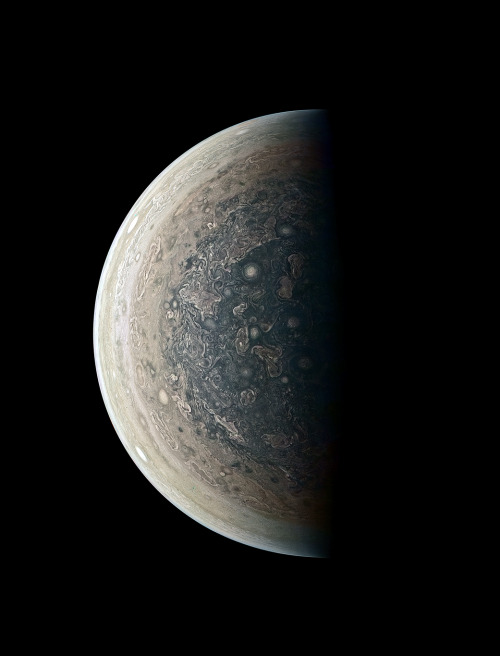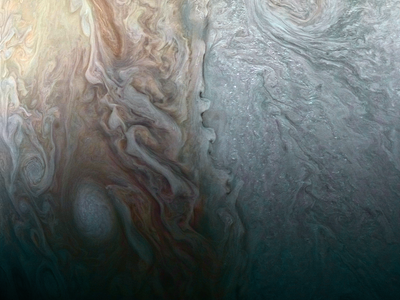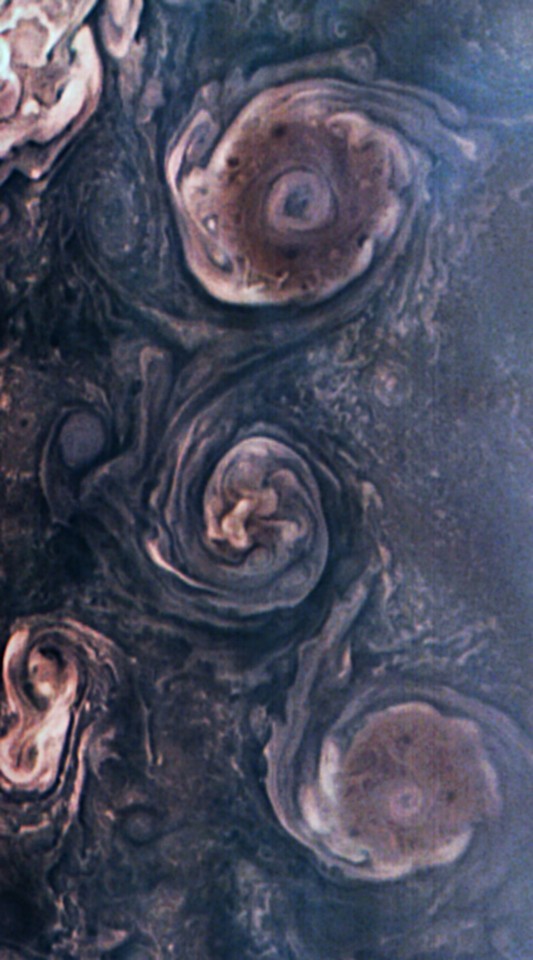Watching You Watching Me. See The “face” Of Jupiter In This Enhanced Color JunoCam Image.

Watching you watching me. See the “face” of Jupiter in this enhanced color JunoCam image.
This citizen scientist-processed image was taken on May 19, 2017. By rotating the image 180 degrees and orienting it from south up, two white oval storms turn into eyeballs, and the “face” of Jupiter is revealed.
More Posts from Monecky and Others

The largest and most powerful hurricanes ever recorded on Earth spanned over 1,000 miles across with winds gusting up to around 200 mph. That’s wide enough to stretch across nearly all U.S. states east of Texas. But even that kind of storm is dwarfed by the Great Red Spot, a gigantic storm in Jupiter. There, gigantic means twice as wide as Earth.
With tumultuous winds peaking at about 400 mph, the Great Red Spot has been swirling wildly over Jupiter’s skies for the past 150 years—maybe even much longer than that. While people saw a big spot in Jupiter as early as they started stargazing through telescopes in the 1600s, it is still unclear whether they were looking at a different storm. Today, scientists know the Great Red Spot is there and it’s been there for a while, but they still struggle to learn what causes its swirl of reddish hues.
Image credit: NASA/JPL

A Cup of Jove. Jupiter cloud formations resemble cream swirling in coffee in this new view taken by NASA’s Juno spacecraft.











Images of Jupiter taken by JunoCam on NASA’s Juno spacecraft.
Credit: NASA, JPL-Caltech, Mission Juno, Jason Major, Luca Fornaciari, Gerald Eichstädt

Unusual hexagonal cloud pattern surrounding Saturn’s north pole. Credit:NASA, JPL-Caltech, SSI, Maksim Kakitsev





canon
foto minha
paris

Same same but different. See cloud patterns near #Jupiter’s south pole in this series of color-enhanced images captured during my latest flyby of the planet.




“Dumbledore has imprisoned himself in Hogwarts”
-
 augustrainbabe liked this · 5 years ago
augustrainbabe liked this · 5 years ago -
 spaxey reblogged this · 5 years ago
spaxey reblogged this · 5 years ago -
 worldart1 reblogged this · 6 years ago
worldart1 reblogged this · 6 years ago -
 pumpkin-kitten-n liked this · 6 years ago
pumpkin-kitten-n liked this · 6 years ago -
 thought-ripples liked this · 6 years ago
thought-ripples liked this · 6 years ago -
 asdmanda liked this · 6 years ago
asdmanda liked this · 6 years ago -
 rossacorsa liked this · 6 years ago
rossacorsa liked this · 6 years ago -
 durzarya reblogged this · 6 years ago
durzarya reblogged this · 6 years ago -
 durzarya liked this · 6 years ago
durzarya liked this · 6 years ago -
 bro-vangogh liked this · 6 years ago
bro-vangogh liked this · 6 years ago -
 monstercreator23 liked this · 6 years ago
monstercreator23 liked this · 6 years ago -
 jahoonus reblogged this · 6 years ago
jahoonus reblogged this · 6 years ago -
 s4v3d liked this · 6 years ago
s4v3d liked this · 6 years ago -
 colleen77043 liked this · 6 years ago
colleen77043 liked this · 6 years ago -
 thatguygeorge reblogged this · 6 years ago
thatguygeorge reblogged this · 6 years ago -
 thatguygeorge liked this · 6 years ago
thatguygeorge liked this · 6 years ago -
 6xixs-blog liked this · 6 years ago
6xixs-blog liked this · 6 years ago -
 bluereadingdolphin liked this · 6 years ago
bluereadingdolphin liked this · 6 years ago -
 i-s-d-m-8 liked this · 6 years ago
i-s-d-m-8 liked this · 6 years ago -
 repetitive-tautology liked this · 6 years ago
repetitive-tautology liked this · 6 years ago -
 local-friendly-cryptid liked this · 6 years ago
local-friendly-cryptid liked this · 6 years ago -
 ajc18615425 liked this · 6 years ago
ajc18615425 liked this · 6 years ago -
 zinadupree liked this · 6 years ago
zinadupree liked this · 6 years ago -
 embodyingdivinity liked this · 6 years ago
embodyingdivinity liked this · 6 years ago -
 giorgioooo-blog1 liked this · 6 years ago
giorgioooo-blog1 liked this · 6 years ago -
 act8 reblogged this · 6 years ago
act8 reblogged this · 6 years ago -
 the-fae-folk liked this · 6 years ago
the-fae-folk liked this · 6 years ago -
 timidmeudwy liked this · 6 years ago
timidmeudwy liked this · 6 years ago -
 expl0ring-possibilities reblogged this · 6 years ago
expl0ring-possibilities reblogged this · 6 years ago -
 sincerely-scorpio liked this · 6 years ago
sincerely-scorpio liked this · 6 years ago -
 abodeglued liked this · 6 years ago
abodeglued liked this · 6 years ago -
 harmonic-psyche liked this · 6 years ago
harmonic-psyche liked this · 6 years ago -
 somnus-is-sleepy liked this · 6 years ago
somnus-is-sleepy liked this · 6 years ago